ANALYSIS
Foraminiferal Assemblages and Age of the Sardar Group
 Zaladu section. The oldest foraminiferal assemblage occurs in Unit 2 of the Zaladu section
(Figure 4, Figure
5, and
Figure 6). The majority of the species range widely from the Serpukhovian to lowermost Bashkirian. The presence of primitive Plectostaffella (Plectostaffella) seslavica of the Pl. varvariensis group
(Figure 7), allows the correlation of the upper portion of this unit to the Plectostaffella varvariensis Zone of the basal Bashkirian in the stratotype region of the Urals (Kulagina et al. 2001).
The age of this zone in the Urals is confirmed as Bashkirian based on the occurrence of conodonts Declinognathodus noduliferus zone and ammonoids of the Homoceras-Hudsonoceras zone (Kulagina et al. 2000).
Zaladu section. The oldest foraminiferal assemblage occurs in Unit 2 of the Zaladu section
(Figure 4, Figure
5, and
Figure 6). The majority of the species range widely from the Serpukhovian to lowermost Bashkirian. The presence of primitive Plectostaffella (Plectostaffella) seslavica of the Pl. varvariensis group
(Figure 7), allows the correlation of the upper portion of this unit to the Plectostaffella varvariensis Zone of the basal Bashkirian in the stratotype region of the Urals (Kulagina et al. 2001).
The age of this zone in the Urals is confirmed as Bashkirian based on the occurrence of conodonts Declinognathodus noduliferus zone and ammonoids of the Homoceras-Hudsonoceras zone (Kulagina et al. 2000).
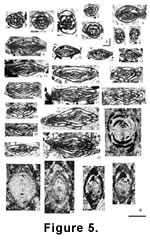 Unit 3 contains a sparse foraminiferal assemblage, which includes Plectostaffella (Plectostaffella) bogdanovskensis, an index-species of the lower subzone of the Eostaffella pseudostruvei Zone, established in the Urals above Plectostaffella varvariensis Zone (Kulagina et al. 2001). Based on the occurrence of characteristic species such as Plectostaffella (Plectostaffella) bogdanovkensis, Pl. (Pl.) varvariensis, Eostaffella pseudostruvei angusta and E. designata
(Figure 7), the greater part of Unit 4 (up to the level of sample Z171) can also be assigned to the Eostaffella pseudostruvei Zone. In general, Units 2 and 3, and most of Unit 4 are correlated with the Syuranian sensu lato (= Bogdanvian + Kamennogorian Regional Stages) substage of the Bashkirian Stage of the Urals (Kulagina et al. 2001) (Figure 2). The first appearance of Pseudostaffella – Ps. antiqua – in this section occurs at the level of sample Z177). At the top of Unit 4 this species is associated with more derived and abundant forms of Pseudostaffella, such as Ps. paracompressa and Ps. composita
(Figure 8). The presence of primitive but diverse Pseudostaffella, abundant Semistaffella, Plectostaffella (Plectostaffella), and Plectostaffella (Varistaffella), and the absence of Profusulinella and Ozawainella permits a reliable correlation of the upper part of Unit 4 to the Akavassian regional Stage of Bashkirian of the Urals and to the Severokeltmenian regional stage of Bashkirian in the East-European Platform (Kulagina et al. 2001).
Unit 3 contains a sparse foraminiferal assemblage, which includes Plectostaffella (Plectostaffella) bogdanovskensis, an index-species of the lower subzone of the Eostaffella pseudostruvei Zone, established in the Urals above Plectostaffella varvariensis Zone (Kulagina et al. 2001). Based on the occurrence of characteristic species such as Plectostaffella (Plectostaffella) bogdanovkensis, Pl. (Pl.) varvariensis, Eostaffella pseudostruvei angusta and E. designata
(Figure 7), the greater part of Unit 4 (up to the level of sample Z171) can also be assigned to the Eostaffella pseudostruvei Zone. In general, Units 2 and 3, and most of Unit 4 are correlated with the Syuranian sensu lato (= Bogdanvian + Kamennogorian Regional Stages) substage of the Bashkirian Stage of the Urals (Kulagina et al. 2001) (Figure 2). The first appearance of Pseudostaffella – Ps. antiqua – in this section occurs at the level of sample Z177). At the top of Unit 4 this species is associated with more derived and abundant forms of Pseudostaffella, such as Ps. paracompressa and Ps. composita
(Figure 8). The presence of primitive but diverse Pseudostaffella, abundant Semistaffella, Plectostaffella (Plectostaffella), and Plectostaffella (Varistaffella), and the absence of Profusulinella and Ozawainella permits a reliable correlation of the upper part of Unit 4 to the Akavassian regional Stage of Bashkirian of the Urals and to the Severokeltmenian regional stage of Bashkirian in the East-European Platform (Kulagina et al. 2001).
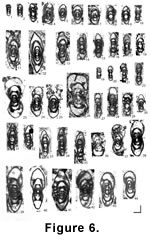 The fusulinid assemblage of Unit 5 (samples Z189-231) contains abundant Aljutovella and Profusulinella, Pseudostaffella subquadrata, and Ozawainella of early Moscovian age
(Figure 9 and
Figure 10). At the top of Unit 4, fusulinids are represented mainly by Eostaffella and primitive Pseudostaffella, which are probably early Bashkirian or later. This suggests the existence of a hiatus between Units 4 and 5. The fusulinids of the lower part of Unit 5 are dominated by Profusulinella parva, Pr. staffellaeformis, Pr. convoluta, Aljutovella sp. 1 (ex gr. Al. subaljutovica ), Al. artificialis, that are typical for the Vereian regional Stage of the East-European Platform. Persistent Archaediscida and earliest primitive Fusiella also occur in Unit 5.
The fusulinid assemblage of Unit 5 (samples Z189-231) contains abundant Aljutovella and Profusulinella, Pseudostaffella subquadrata, and Ozawainella of early Moscovian age
(Figure 9 and
Figure 10). At the top of Unit 4, fusulinids are represented mainly by Eostaffella and primitive Pseudostaffella, which are probably early Bashkirian or later. This suggests the existence of a hiatus between Units 4 and 5. The fusulinids of the lower part of Unit 5 are dominated by Profusulinella parva, Pr. staffellaeformis, Pr. convoluta, Aljutovella sp. 1 (ex gr. Al. subaljutovica ), Al. artificialis, that are typical for the Vereian regional Stage of the East-European Platform. Persistent Archaediscida and earliest primitive Fusiella also occur in Unit 5.
 Starting with sample Z220, the lowermost Kashirian species present are Ozawainella vozhgalica, Pseudostaffella subquadrata, Profusulinella ovata, P. polasnensis, Aljutovella complicata, Al. priscoidea, Al. cafirniganica, Al. aff. devexa, and others
(Figure 10,
Figure 11,
Figure 12). Their occurrences suggest a late Vereian-early Kashirian age for the lower part of Unit 5 or the basal part of Absheni Formation. The upper part of Ghaleh Formation is Akavassian in age. Therefore, the hiatus between the formations encompasses the upper half of the Bashkirian Stage (Askynbashian-Asatauian regional Stages) and, probably, the lowermost Moscovian.
Starting with sample Z220, the lowermost Kashirian species present are Ozawainella vozhgalica, Pseudostaffella subquadrata, Profusulinella ovata, P. polasnensis, Aljutovella complicata, Al. priscoidea, Al. cafirniganica, Al. aff. devexa, and others
(Figure 10,
Figure 11,
Figure 12). Their occurrences suggest a late Vereian-early Kashirian age for the lower part of Unit 5 or the basal part of Absheni Formation. The upper part of Ghaleh Formation is Akavassian in age. Therefore, the hiatus between the formations encompasses the upper half of the Bashkirian Stage (Askynbashian-Asatauian regional Stages) and, probably, the lowermost Moscovian.
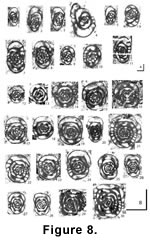 The middle and upper parts of Unit 5 of the Zaladu section are referred to the Kashirian by the occurrence of Putrella aff. donetziana (samples Z235 and Z244). In the Moscow Basin, Putrella has
been found recovered from the upper Moscovian.
Putrya (1956) also considered Putrella donetziana to be of late Moscovian (Myachkovian) age. The forms he attributed to this species, however, seem to differ from the type species of Putrella described
from Donets Basin by
Lee (1937). Our assessment that the upper part of Unit 5 is Kashirian in age is based on the fact that the entire assemblage of the fusulinids, excluding Putrella, is similar to that found in the lower part of Unit 5. Secondly, the pre-Podolian age of this portion of the Zaladu section is also confirmed by the absence of fusulinids typical of the transitional beds between the lower and upper Moscovian substages. These fusulinids include, but are not limited to, the earliest Fusulinella, Beedeina, Citronites, and Paraeofusulina. Unit 6 lacks fusulinids and is assigned to the upper Moscovian (most likely Podolian) by its stratigraphic position.
The middle and upper parts of Unit 5 of the Zaladu section are referred to the Kashirian by the occurrence of Putrella aff. donetziana (samples Z235 and Z244). In the Moscow Basin, Putrella has
been found recovered from the upper Moscovian.
Putrya (1956) also considered Putrella donetziana to be of late Moscovian (Myachkovian) age. The forms he attributed to this species, however, seem to differ from the type species of Putrella described
from Donets Basin by
Lee (1937). Our assessment that the upper part of Unit 5 is Kashirian in age is based on the fact that the entire assemblage of the fusulinids, excluding Putrella, is similar to that found in the lower part of Unit 5. Secondly, the pre-Podolian age of this portion of the Zaladu section is also confirmed by the absence of fusulinids typical of the transitional beds between the lower and upper Moscovian substages. These fusulinids include, but are not limited to, the earliest Fusulinella, Beedeina, Citronites, and Paraeofusulina. Unit 6 lacks fusulinids and is assigned to the upper Moscovian (most likely Podolian) by its stratigraphic position.
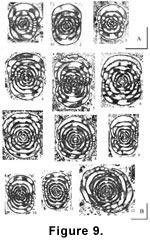 Based on these observations in the Zaladu section, the type section of the Ghaleh and Absheni Formations, we conclude that the Ghaleh Formation is lower Bashkirian in age. The data presented here do not confirm that Ghaleh Formation includes Lower Carboniferous deposits, as previously proposed (Stöcklin et al. 1965;
Stepanov 1971). Because the lowermost beds were not collected, however, we cannot at present, exclude the possibility that these beds may belong to the Serpukhovian Stage.
Based on these observations in the Zaladu section, the type section of the Ghaleh and Absheni Formations, we conclude that the Ghaleh Formation is lower Bashkirian in age. The data presented here do not confirm that Ghaleh Formation includes Lower Carboniferous deposits, as previously proposed (Stöcklin et al. 1965;
Stepanov 1971). Because the lowermost beds were not collected, however, we cannot at present, exclude the possibility that these beds may belong to the Serpukhovian Stage.
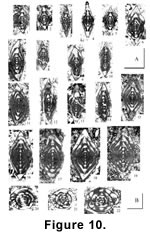 We also consider the entire Absheni Formation to be of Moscovian age. It rests on the Ghaleh Formation with a stratigraphic hiatus corresponding to the greatest part of the Bashkirian Age and probably the basal most beds of the lower Moscovian. It is quite possible that the upper half, and most likely the lower part, of the Absheni Formation includes the upper Moscovian. The uppermost part of the Moscovian, as well as the Kasimovian and most probably the greatest part of Gzhelian stages, are absent from this section.
We also consider the entire Absheni Formation to be of Moscovian age. It rests on the Ghaleh Formation with a stratigraphic hiatus corresponding to the greatest part of the Bashkirian Age and probably the basal most beds of the lower Moscovian. It is quite possible that the upper half, and most likely the lower part, of the Absheni Formation includes the upper Moscovian. The uppermost part of the Moscovian, as well as the Kasimovian and most probably the greatest part of Gzhelian stages, are absent from this section.
 Anarak section. Foraminiferal assemblages, more abundant than in the Zaladu section, are present in the Anarak section. The section consists of separate, frequently displaced blocks (Figure 3), the initial succession of which can be reconstructed with much confidence. The shale of Unit 1 that lies below the foraminifer-rich limestone of Unit 2 and is devoid of foraminifers, was referred to as the lower Bashkirian. Primitive Pseudostaffella (Ps. cf. Ps. antiqua) are associated with Eostaffella, Semistaffella, Plectostaffella, and abundant Archaediscidea span the lower half of Unit 2 (samples A40-A71). Accordingly, most of the lower half of Unit 2 can be correlated to the Varistaffella ziganica-Pseudostaffella antiqua
Zone (Kulagina et al. 2001). This zone is the lowest Akavassian regional stage of the Bashkirian of the Urals (Figure 2).
Anarak section. Foraminiferal assemblages, more abundant than in the Zaladu section, are present in the Anarak section. The section consists of separate, frequently displaced blocks (Figure 3), the initial succession of which can be reconstructed with much confidence. The shale of Unit 1 that lies below the foraminifer-rich limestone of Unit 2 and is devoid of foraminifers, was referred to as the lower Bashkirian. Primitive Pseudostaffella (Ps. cf. Ps. antiqua) are associated with Eostaffella, Semistaffella, Plectostaffella, and abundant Archaediscidea span the lower half of Unit 2 (samples A40-A71). Accordingly, most of the lower half of Unit 2 can be correlated to the Varistaffella ziganica-Pseudostaffella antiqua
Zone (Kulagina et al. 2001). This zone is the lowest Akavassian regional stage of the Bashkirian of the Urals (Figure 2).
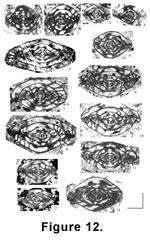 Pseudostaffella are abundant and diverse in Unit 2, whereas Profusulinella and Ozawainella are absent (samples A72-A86). These fauna allow the assignment of the upper portion of Unit 2 to the upper half of the Akavassian regional stage and probably the basal portion of the Askynbashian regional stage. The same assemblage is present in the displaced limestone block of Unit 2a, which occurs higher in the sections than the shale of Unit 4 (Figure 3). The block includes a diverse sample of species of Pseudostaffella and abundant Eostaffella and Archaediscidae (samples A150-A160). The lower portion of the block (samples A144 and A148) contains a younger foraminiferal assemblage, in which Pseudostaffella is associated with a new occurrence of Profusulinella, Ozawainella, and early species of Aljutovella. This assemblage is characteristic of the uppermost Bashkirian and implies that the overturned position of the limestone block of Unit 2a originated between Units 4 and 5. The fusulinid assemblages in the lower and upper portions of the limestone block of Unit 2a suggest a hiatus that corresponds to the Tashastinian regional stage of the Urals. Because of the tectonic nature of this block, however, we cannot exclude additional complications within it. A stratigraphic unconformity between Unit 2 and Unit 3 is quite possible, as the upper Bashkirian is missing. However, the possibility of tectonic contact between Units 2 and 3 cannot be excluded.
Pseudostaffella are abundant and diverse in Unit 2, whereas Profusulinella and Ozawainella are absent (samples A72-A86). These fauna allow the assignment of the upper portion of Unit 2 to the upper half of the Akavassian regional stage and probably the basal portion of the Askynbashian regional stage. The same assemblage is present in the displaced limestone block of Unit 2a, which occurs higher in the sections than the shale of Unit 4 (Figure 3). The block includes a diverse sample of species of Pseudostaffella and abundant Eostaffella and Archaediscidae (samples A150-A160). The lower portion of the block (samples A144 and A148) contains a younger foraminiferal assemblage, in which Pseudostaffella is associated with a new occurrence of Profusulinella, Ozawainella, and early species of Aljutovella. This assemblage is characteristic of the uppermost Bashkirian and implies that the overturned position of the limestone block of Unit 2a originated between Units 4 and 5. The fusulinid assemblages in the lower and upper portions of the limestone block of Unit 2a suggest a hiatus that corresponds to the Tashastinian regional stage of the Urals. Because of the tectonic nature of this block, however, we cannot exclude additional complications within it. A stratigraphic unconformity between Unit 2 and Unit 3 is quite possible, as the upper Bashkirian is missing. However, the possibility of tectonic contact between Units 2 and 3 cannot be excluded.
The presence of Neostaffella and the relatively derived Ozawainella, Aljutovella, Profusulinella indicates a Moscovian age of Unit 3. The species composition within this unit is characteristic of the upper Vereian-lower Kashirian of the lower Moscovian in the East European platform. Similar assemblages occur in the lower portion of Unit 4 (samples A120 and A121) of the Anarak section and the lower half of Unit 5 of the Zaladu section. The upper part of Unit 4 is correlated to the Kashirian Regional stage by the presence of the earliest Putrella (sample A139).
Abundant Putrella were also found in Unit 5 (samples A175, A183, and A184). More derived forms of the genus suggest a younger age of the enclosing deposits. Putrella is associated with the earliest Fusulinella, i.e., the subgenus F. (Moellerites) (sample A184), earliest
Beedeina, and highly derived Neostaffella (N. syzranica type).
The entire set of genera and species is characteristic of the interval from the upper Kashirian Regional stage of the lower Moscovian through lower Podolian Regional stage of upper Moscovian. The uppermost part of Unit 5 contains sparse foraminifers. Derived forms of Fusiella, such as F. typica and F. paradoxa, as well as poorly preserved specimens resembling Fusulina, are typical of the Myachkovian Regional stage of the Moscovian Stage, but an older age cannot be excluded.
In summary, we recognize a great similarity between the Zaladu and Anarak sections. Both sections of the Sardar Group consist predominantly of carbonate in the lower Ghaleh Formation and of siliciclasts in the upper part Absheni Formation. The Ghaleh Formation is restricted to the Bashkirian and the Absheni Formation to the Moscovian. The Sardar Group is bounded by unconformities in both Ozbak-Kuh and Anarak areas. An indication of unconformity between Ghaleh and Absheni Formations, however, was not documented in the field.
Although similar in several ways, the two formations differ in certain details, especially those concerning the age of the Ghaleh Formation (Figure 2). In the Zaladu section, the uppermost part of Unit 4, is correlated with the Akavassian Regional stage of the Urals. In the Anarak section, however, the Akavassian fusulinids appear at the base of limestone of Unit 2. This implies a possible correlation of Unit 1 and the underlying limestone of the Anarak section and Units 1,2,3 and major part of 4 of the Ghaleh Formation in the Zaladu section to the lower Bashkirian (Syuranian s.l. Substage). There is no paleontological evidence, however, to confirm this suggestion.
The data presented above show that the uppermost portion of Unit 2 in the Anarak section is related to the lower portion of the Askynbashian Regional stage of the Bashkirian. If our hypothesis that the displaced limestone block 2a belongs to Unit 2 is correct, then the top of the Ghaleh Formation in the Anarak section, where the upper half of the Bashkirian falls into the hiatus between Ghaleh and Absheni Formations, is younger than in the Zaladu section.
The Absheni Formation in both sections is Moscovian in age. The lower part of the Formation in both sections includes beds attributable to the upper Vereian-Kashirian of the lower Moscovian. The topmost part of the shale (i.e., the upper part of the
formation) can be assigned to the upper Moscovian. However, this assignment has not been confirmed by reliable paleontological evidence.

 Zaladu section. The oldest foraminiferal assemblage occurs in Unit 2 of the Zaladu section
(Figure 4, Figure
5, and
Figure 6). The majority of the species range widely from the Serpukhovian to lowermost Bashkirian. The presence of primitive Plectostaffella (Plectostaffella) seslavica of the Pl. varvariensis group
(Figure 7), allows the correlation of the upper portion of this unit to the Plectostaffella varvariensis Zone of the basal Bashkirian in the stratotype region of the Urals (Kulagina et al. 2001).
The age of this zone in the Urals is confirmed as Bashkirian based on the occurrence of conodonts Declinognathodus noduliferus zone and ammonoids of the Homoceras-Hudsonoceras zone (Kulagina et al. 2000).
Zaladu section. The oldest foraminiferal assemblage occurs in Unit 2 of the Zaladu section
(Figure 4, Figure
5, and
Figure 6). The majority of the species range widely from the Serpukhovian to lowermost Bashkirian. The presence of primitive Plectostaffella (Plectostaffella) seslavica of the Pl. varvariensis group
(Figure 7), allows the correlation of the upper portion of this unit to the Plectostaffella varvariensis Zone of the basal Bashkirian in the stratotype region of the Urals (Kulagina et al. 2001).
The age of this zone in the Urals is confirmed as Bashkirian based on the occurrence of conodonts Declinognathodus noduliferus zone and ammonoids of the Homoceras-Hudsonoceras zone (Kulagina et al. 2000).







